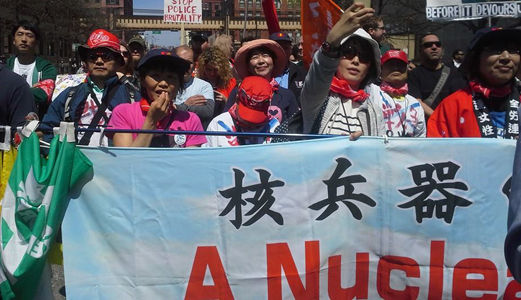
CHICAGO – May 1, 1886 was the day that the Federation of Organized Trades and Labor Unions set as the day the eight-hour workday would become standard; this, after years of agitating and organization, after years of pain and thankless toil. It set into motion a series of actions and strikes nationwide that would culminate with a bombing and the subsequent dubious trial and execution of seven labor radicals in Chicago, today referred to as the Haymarket Martyrs.
On May 1, 2015 in Chicago, the community gathered around the memorial placed at the location of that explosion, on the exact spot from where speakers addressed the crowds from a wagon. The Federation of Organized Trades and Labor has since matured into the AFL-CIO, whose constituent unions helped organize the event.
In attendance are large contingences from Laborers International Union, United Food and Commercial Workers, the International Brotherhood of Electrical Workers and the Fight for $15 campaign. The crowd numbers in the hundreds, not unlike the crowd on that fateful day. Their leaders took to the stage one-by-one to pump up the crowd, and plenty of union songs were sung.
What was especially heartening was the heavy international contingent that was also on hand to commemorate those bold workers whose sacrifice would come to mean so much across the world after, in 1889, the Second International declared May 1st International Workers Day (to the chagrin and continuous rejection of the U.S. government).
One of the guests from abroad is Tobias Bhudin, first vice president from the Swedish Trade Union Federation who was in attendance to unveil and present a plaque for the martyrs monument. On the plaque is their trade union vow which new members of the Swedish unions recite.
“It comes from the childhood of our labor union when we promised each other not to work under worse conditions, not for a low salary, and not work more than eight hours per day. Its what we talk about every day in Swedish labor unions.”
The plaque itself says as much, translated into English and also includes a cornerstone of class struggle logic: “We make this vow in the secure knowledge that if we all are true to our pledge, the employer will be forced to meet our demands.”
When asked what issues unions in Sweden are organizing around, Bhudin answers with a familiar list including the right to organize and more job security.
Perhaps the most conspicuous group on hand was the delegation from Zenroren, the National Confederation of Trade Unions in Japan. They carried several elaborate banners calling for nuclear disarmament. They were also collecting signatures for the effort.
“Hiroshima and Nagasaki was something that happened years ago, but workers in Japan are aware that if there is another use of nuclear weapons, there can be no good working conditions so that is why working for nuclear abolition is also fighting for workers rights”, said Noriko Yamamoto.
The rally was held on Desplaines Street below an imposing advertisement for the Disney film, Tomorrowland. I can’t speak for the movie, but the Tomorrowland section of Disney World puts forth an idealized image of social progress and projects that idealism far into the future. The dubious values of Disney executives aside, you can’t help but think about what the future has in store for our planet.
As long as the workers uphold the solidarity I saw on May Day, then I remain hopeful.
Photo: At Chicago’s May Day Rally, Japanese carry banner for a nuclear free world. | Teresa Albano/PW












Comments